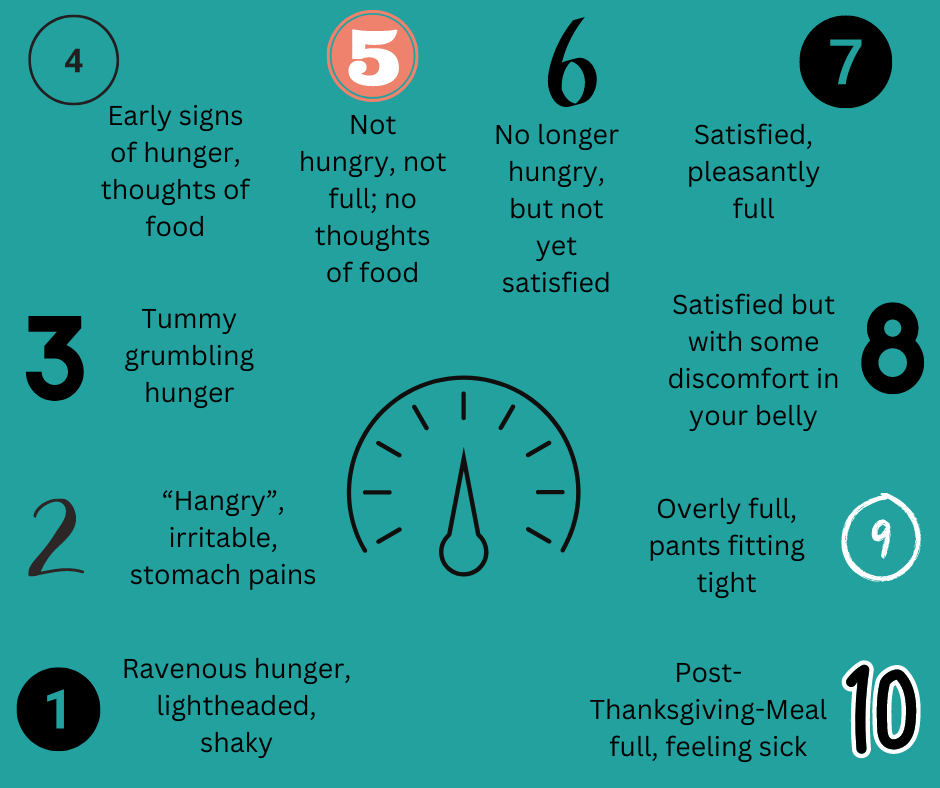How much should I eat? When should I be eating?
These are common questions that I get from clients (and also in casual conversations with people I meet!) that don’t have a simple answer. While for some, it can be quite obvious that they are not eating enough or eating too much or going too long without eating, for others, it may not be as clear. In these situations, I like to start with a conversation about the hunger/fullness scale.

What is the hunger/fullness scale?
The hunger/fullness scale is a tool that can be used to talk about how much and when to eat. Let’s dive in by starting in the middle at #5. I describe this point as the absence of hunger or fullness. You’re not thinking about food but you’re also not hungry. Personally, I might feel a level 5 somewhere around an hour or two after eating a meal. For some people, this point might happen sooner after a meal and for others it might happen later. Let me stress that this is an individualized scale. The point is that it can be helpful for each person to explore this in their own bodies as it can be useful information during times of stress, anxiety, illness, etc when our hunger/fullness cues may be out of whack (or we’re not able to notice them).
Now that we know what the middle feels like, let’s look at the lower numbers on the scale. As you can see from the scale, the further we get from number 5, the hungrier we have become. I associate number 4 with earlier signs of hunger such as thoughts about food but no physical symptoms. If we keep going without eating anything, we find ourselves entering number 3 where we start to experience the classic physical symptom of tummy grumbling. If we ignore this hunger cue and continue without eating, we may start seeing some of those other more annoying hunger cues such as irritability, shakiness, dizziness, fatigue, etc as we pass from level 2 into 1. A level 1 reminds me of the time that a doctor scheduled me for fasting lab work at 11:00 in the morning. As someone who eats breakfast typically by 7:00 or 8:00, I was ravenous, nauseous, shaky and irritable by the time I made it home to eat something after the appointment.
On the opposite end of the scale, we see our fullness levels increase as we eat more food. For me, a level 6 feels like I have stopped midway without finishing a meal. I’m no longer hungry, but I will definitely need to eat again soon if I don’t eat more in this moment. I describe level 7 as the sweet spot after a meal- I’m satisfied and pleasantly full but not uncomfortable. The more I eat past this point (oftentimes when I am really enjoying a meal or dessert is offered with the meal) I enter a level 8 and onto a level 9. As you may have seen from an earlier post here, I describe level 10 as “Post-Thanksgiving-Meal Full” but really it is that level of overfullness that leaves you feeling like you may vomit if you eat another bite.
How to use the scale?
When working with someone on the hunger/fullness scale, I typically have them briefly glance over my example of a scale and then take a piece of paper and write 1-10 down the side of the paper. Then together, we talk about the different levels of hunger and fullness and I have them reflect and write down a few notes about the last time they remember feeling each level of fullness.
How can this information be helpful moving forward?
Finally, we can take this information and use if for guidance around when and how much to eat. You may ask why we would ever need to do this if we’re intuitive eaters? Well, we can have life factors getting in the way of us being in tune with our natural hunger and fullness cues such as during times of high stress, anxiety, depression and illness.
Here’s a personal example to help me explain: I know that a regular bowl of cereal with milk leaves me around a number 6. I’m no longer hungry, but I will definitely need to eat again in 2ish hours. If I try to wait my normal 4 hours until lunch, I will likely reach a level 2 and be pretty irritable and have difficulty concentrating. That being said, we recently sustained water damage in our house and there were several days of insurance adjusters, remediation, contractors, etc which brought the level of stress in my life to a pretty high level. On day #3 of this situation, I found myself “all of a sudden” very hangry with hunger pains in my stomach and feeling lightheaded. I quickly stopped and realized that I had somehow skipped lunch- I hadn’t noticed any of my normal earlier signs of hunger and had been too distracted to really pay attention to the time. For the next few days, I reverted to using my hunger/fullness scale for guidance. I ate more by the clock and used typical servings of food for me when figuring out how much to eat at a meal instead of trying to listen to my body in the moment.
Whether you’re in recovery from an eating disorder or simply working on your journey to intuitive eating, reviewing and reflecting on a hunger/fullness scale can be a useful tool. Looking for more guidance around this topic or other parts of intuitive eating? Reach out- I would love to help.
